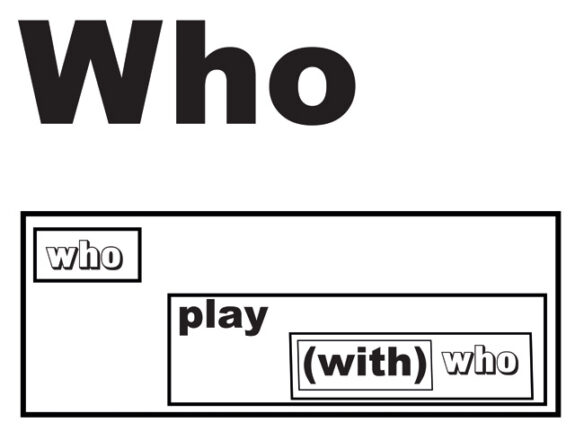
Regularities
And universals
While the irregularities of language are obvious in contrasts like fall and fell, stand and stood, often taken to be ‘the grammar’, there are regularities and universals which are not obvious at all, but hidden, by the proposal here, by the way human speech and language have evolved.
Some of the hidden regularities are first confronted by language learners in questions with who, what, where and other such words, pronounced at one position in the structure, on the left edge, and understood somewhere else in the structure. This possibility appears to be universally available. It is actively exploited in most languages, including English,
A four year old on his or her first day at school may be asked “Who do you want to play with?” or “Who do you want to play with you?” In one sense, they mean much the same. But in the underlying structures, who relates to different elements in different positions. So competent speakers understand the two questions in correspondingly different ways. In “Who does she want to play with?” she is the would-be player. In “Who does she want to play with her?” the would-be player is anyone but she. Although the difference is by only by one final word, the onus in any response is quite different in each case. A child might seem to respond appropriately to questions of this sort without making the analysis of a fully competent adult speaker. Such a full analysis involves putting together two of the principles which the child first starts to master much earlier – in the first three years, by the proposal here.
By the framework here, words like who are copied from various positions in the structure other than those where they are eventually pronounced. Forcibly there is a derivation. This is not taught in school. Nor could it be. But native speakers of English understand the principles of this derivation accurately and reliably and without a word of instruction.
The grammar on this point involves not one, but five sorts of universal.
- By what is known as ‘case’, in English, as in most languages, a difference is markes between she and her in “Who does she want to play with her?”
- By what is known as ‘person’ the reference here is to anybody other than the speaker nor the listener,
- By what is known as number, she is differentiated from they. Number and person are both features of the meaning, reflected in whether do is said as does.
- By what used to be known as ‘inflection’ and is now mostly known as ‘Tense’, in “Who does she want to play with?” and “Who did she want to play with?” do and did specify different time planes of reference.
- A newly discovered universal is known, in the framework, here as ‘control’. In “She wants to play” wants controls play. This could not mean “She wants to play tomorrow” or “She wants her to play”. Want controls both the person and the tense of play.
These universals distinctly characterise the framework here. They are part of a universally available apparatus. The simplest explanation of the universality is that it is specified by the human genome. But any one or more of these universals may be problematic for some children. If a child does have such a problem here, he or she probably needs help. The accessibility of such universals to a child is a sensitive diagnostic.

